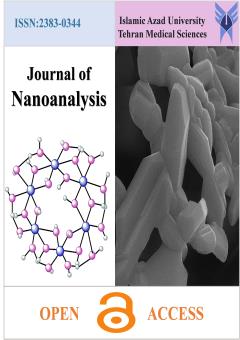Metal‐Supported Mesoporous Aluminosilicate Catalysts for Selective Catalytic Decomposition
Subject Areas : Journal of NanoanalysisZahra Amirsardari 1 * , Akram Dourani 2 , Nooredin Ghadiri Massoom 3
1 - Space Transportation Research Institute, Iranian space research center, Tehran, Iran
2 - Space Transportation Research Institute, Iranian space research center, Tehran, Iran
3 - Space Transportation Research Institute, Iranian space research center, Tehran, Iran
Keywords: Catalyst, Aluminosilicate, Support, Iridium nanoparticles, Decomposition parameters,
Abstract :
Iridium catalysts with the active component content of 10, 20, and 30 wt% on mesoporous aluminosilicate have been synthesized by the reductive hydrolysis of iridium chloro complexes. The degree of dispersion of supported iridium was controlled by increasing the weight percentage of iridium nanoparticles in the catalyst. In this research, it was shown that the crushing strength of the catalysts synthesized on the basis of aluminosilicate with different weight percentages of iridium nanoparticles can be different. The results of hydrazine decomposition show that the performance of the catalysts increases from 10 wt% to 20 wt%, and subsequently, by increasing the concentration of iridium to 30% by weight, with the decomposition parameters remaining constant, the resistance to crushing of the catalyst decreases. The present work is intended to provide some useful correlations between the iridium catalytic activity and the potential parameters in the support materials, and thus making the process more active.
[1]. Tang P, Wen H, Wang P. Hierarchically nanostructured Ni2Fe2N as an efficient electrocatalyst for hydrazine oxidation reaction. Chem Eng J. 2022;431:134123.
[2]. P. Yang, L. Yang, Q. Gao, Q. Luo, X. Zhao, X. Mai, Q. Fu, M. Dong, J. Wang YH. Anchoring carbon nanotubes and post-hydroxylation treatment enhanced Ni nanofiber catalysts towards efficient hydrous hydrazine decomposition for effective hydrogen generation. Chem Commun. 2019;55(61):9011–4.
[3]. Amirsardari Z, Dourani A, Amirifar MA, Ghadiri Massoom N, Afzali B. Distribution and grain size support-dependent catalytic properties of iridium nanoparticles. J Nanoanalysis. 2021;8(3):199–208.
[4]. Zhang M, Liu L, Lu S, Xu L, An Y, Wan C. Facile fabrication of NiPt/CNTs as an efficient catalyst for hydrogen production from hydrous hydrazine. ChemistrySelect. 2019;4(35):10494–500.
[5]. Amirsardari Z, Dourani A, Amirifar MA, Massoom NG. Comparative characterization of iridium loading on catalyst assessment under different conditions. Int J Miner Metall Mater. 2021;28(7):1233–9.
[6]. Zhang W, Xia S, Chen C, He H, Jin Z, Luo M, et al. Understanding the crucial roles of catalyst properties in ethyl acetate and toluene oxidation over Pt catalysts. New J Chem. 2021;45(25):11352–8.
[7]. Long D, Chen Q, Qiao W, Zhan L, Liang X, Ling L. Three-dimensional mesoporous carbon aerogels: ideal catalyst supports for enhanced H2S oxidation. Chem Commun. 2009;(26):3898–900.
[8]. Salavati-Niasari M, Bazarganipour M. Synthesis, characterization and catalytic oxidation properties of multi-wall carbon nanotubes with a covalently attached copper (II) salen complex. Appl Surf Sci. 2009;255(17):7610–7.
[9]. Lu X, Francis S, Motta D, Dimitratos N, Roldan A. Mechanistic study of hydrazine decomposition on Ir (111). Phys Chem Chem Phys. 2020;
[10]. Amirsardari Z, Dourani A, Hasanpour F, Amirifar MA, Ghadiri N. Effect of silica content on support-iridium active phase interactions on the nanocatalyst activity. J Nanostructures. 2020;10(2):348–61.
[11]. Bellomi S, Barlocco I, Chen X, Delgado JJ, Arrigo R, Dimitratos N, et al. Enhanced stability of sub-nanometric iridium decorated graphitic carbon nitride for H2 production upon hydrous hydrazine decomposition. Phys Chem Chem Phys. 2023;25(2):1081–95.
[12]. Matyshak VA, Silchenkova ON. Catalytic decomposition of hydrazine and hydrazine derivatives to produce hydrogen-containing gas mixtures: a review. Kinet Catal. 2022;63(4):339–50.
[13]. Sanchez SI, Menard LD, Bram A, Kang JH, Small MW, Nuzzo RG, et al. The emergence of nonbulk properties in supported metal clusters: negative thermal expansion and atomic disorder in Pt nanoclusters supported on γ-Al2O3. J Am Chem Soc. 2009;131(20):7040–54.
[14]. Namvar F, Hajizadeh-Oghaz M, Mahdi MA, Ganduh SH, Meshkani F, Salavati-Niasari M. The synthesis and characterization of Ni-M-Tb/Al2O3 (M: Mg, Ca, Sr and Ba) nanocatalysts prepared by different types of doping using the ultrasonic-assisted method to enhance CO2 methanation. Int J Hydrogen Energy. 2023;48(10):3862–77.
[15]. Joshi P, Huang H-H, Yadav R, Hara M, Yoshimura M. Boron-doped graphene as electrocatalytic support for iridium oxide for oxygen evolution reaction. Catal Sci Technol. 2020;10(19):6599–610.
[16]. Hauser JL, Amberchan G, Tso M, Manley R, Bustillo K, Cooper J, et al. A mesoporous aluminosilicate nanoparticle-supported nickel–boron composite for the catalytic reduction of nitroarenes. ACS Appl Nano Mater. 2019;2(3):1472–83.
[17]. Li L, Wang X, Zhao X, Zheng M, Cheng R, Zhou L, et al. Microcalorimetric studies of the iridium catalyst for hydrazine decomposition reaction. Thermochim Acta. 2005;434(1–2):119–24.
[18]. Salimi M, Pakdehi SG, Shekarian A. Ir impregnation on alumina pores: catalyst activity and loss during hydrazine decomposition. Propellants, Explos Pyrotech. 2020;
[19]. Pakdehi SG, Rasoolzadeh M. Comparison of catalytic behavior of iridium and nickel nanocatalysts for decomposition of hydrazine. Procedia Mater Sci. 2015;11:749–53.
[20]. Jang IJ, Shin HS, Shin NR, Kim SH, Kim SK, Yu MJ, et al. Macroporous–mesoporous alumina supported iridium catalyst for hydrazine decomposition. Catal today. 2012;185(1):198–204.
[21]. Jang YB, Kim TH, Sun MH, Lee J, Cho SJ. Preparation of iridium catalyst and its catalytic activity over hydrazine hydrate decomposition for hydrogen production and storage. Catal Today. 2009;146(1–2):196–201.
[22]. Armstrong WE, Ryland LB, Voge HH. Catalyst comprising Ir or Ir and Ru for hydrazine decomposition. 1978;
[23]. He L, Liang B, Huang Y, Zhang T. Design strategies of highly selective nickel catalysts for H2 production via hydrous hydrazine decomposition: a review. Natl Sci Rev. 2018;5(3):356–64.
[24]. Amirsardari Z, Dourani A, Amirifar MA, Massoom NG, Javadi A, Ehsani R, et al. Dentate number and functionality of O, N‑donor ligands for the growth and catalytic reaction of iridium nanoparticles. Chem Pap. 2020;74(10):3233–41.

